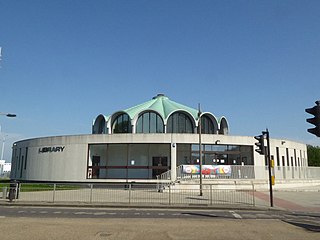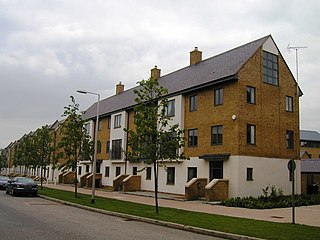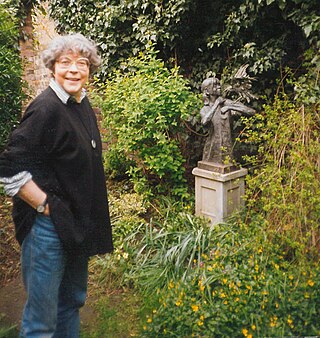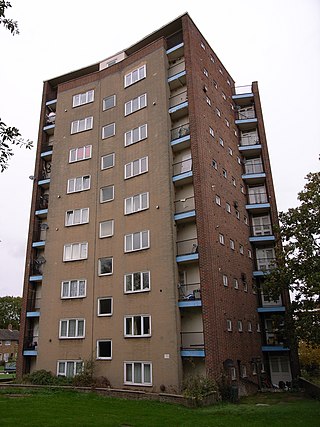
Harlow is a town and local government district located in the west of Essex, England. Founded as a new town, it is situated on the border with Hertfordshire, and occupies a large area of land on the south bank of the upper Stort Valley, which has been made navigable through other towns and features a canal section near its watermill.
The year 1953 in architecture involved some significant events.

Sir Frederick Ernest Gibberd CBE was an English architect, town planner and landscape designer. He is particularly known for his work in Harlow, Essex, and for the BISF house, a design for a prefabricated council house that was widely adopted in post-war Britain.

Sir Arnold Joseph Philip Powell, usually known as Philip Powell, was an English post-war architect.

Barkingside is an area in Ilford, in the London Borough of Redbridge. It includes the major road junction of Fullwell Cross which also gives its name to the locality near that roundabout. The area is situated 10.6 miles (17km) north east of Charing Cross. Prior to 1965, it formed part of the borough of Ilford in the historic county of Essex.

Newhall is a new housing estate within Harlow, Essex, England. In 2009, it was being built on land originally forming part of Soper Farm. A landowner led development, its planners are Roger Evans Associates, an architectural practice based in Oxford. The design of the new neighbourhood is different from the rest of the first generation New Town, featuring striking contemporary architecture. The plan for Newhall precedes government set housing density levels, current sustainability standards and introduced design codes at a time when they were not common.

St Mark's West Essex Catholic School is a Roman Catholic secondary school and sixth form with academy status located in Harlow, Essex, England.
Patricia Russell, Countess Russell was the third wife of philosopher Bertrand Russell and a significant contributor to his book A History of Western Philosophy.

Harlow Town Park is a 164-acre (66 ha) public park in Harlow, Essex, England. The park is one of the largest urban parks in Britain. It includes multiple gardens, a petting zoo named the Pets' Corner, a bandstand, and the Spurriers House Café. It opened in 1957 and was designed by two of the most important figures in 20th Century landscape architecture in Britain: Frederick Gibberd and Sylvia Crowe. Its importance was recognised by Historic England on 18 August 2020 when it was added to the Register of Historic Parks and Gardens as Grade II. The park is set in and around the valley of Netteswell Cross, which includes a stream and a small historic settlement which retains a high level of original character. Several of the buildings are Grade II listed including 6 School Lane, Greyhound Public House, Hill Hall Farmhouse, Hoppitts, and Marshgate Farmhouse. These buildings range in age from the 16th to the late 19th centuries. Harlow Town Park received a large £2.8m grant for renovations in 2014, which were completed in 2016. The park has been awarded a Green Flag on six occasions, recognising the quality of green space management. In 2019 the Park was voted among the most popular 10 parks in the country in the Green Flag People's Choice award.

Gerda Ursula Rubinstein was a Dutch sculptor of figures, birds and animals based in England since 1959 or 1960.

Physical Energy is a bronze equestrian statue by the English artist George Frederic Watts. Watts was principally a painter, but also worked on sculptures from the 1870s. Physical Energy was first cast in 1902, two years before his death, and was intended to be Watts's memorial to "unknown worth". Watts said it was a symbol of "that restless physical impulse to seek the still unachieved in the domain of material things". The original plaster maquette is at the Watts Gallery, and there are four full-size bronze casts: one in London, one in Cape Town, one in Harare and one soon to be sited at Watts Gallery - Artists' Village in Compton, Surrey. Other smaller bronze casts were also made after Watts's death.

Pincey Brook is a watercourse in the Uttlesford and Epping Forest districts of Essex, England, and is a tributary to the River Stort.
Gerard Thomas Goalen was a British architect who specialised in church architecture and was influenced by continental models and the Liturgical Movement. He was one of the most important architects of the Catholic Modernist movement in the United Kingdom during the 20th century.
Angela Godfrey is an English sculptor and Member of the Royal Society of Sculptors.
Harlow Art Trust (HAT) is a registered charity based in Harlow, Essex that was set up in the 1950s to acquire and display sculptures. Having collected many works over the years it now comprises a nationally significant collection located throughout the town. HAT was set up by the lead architect of Harlow New Town Frederick Gibberd. Gibberd wanted the New Town to be a place where people who might not normally have access to art could enjoy great sculptures by great artists on every street corner. Consequently, almost all of Harlow's sculpture collection is in the open air, in shopping centres, housing estates and parks around the town.

The Lawn is a mid-twentieth-century low-rise building located on the outskirts of Old Harlow, to the east of the town of Harlow, Essex, England.

Our Lady of Fatima's Church is a Roman Catholic parish church in Harlow, Essex, England. It was designed between 1953 and 1954 by Gerard Goalen and was one of the earliest churches in England where the design was influenced by the Liturgical Movement. Construction did not begin until 1958 and the church was consecrated in 1960. Notable for its highly decorated interior, the church contains examples of dalle de verre glasswork, which are considered the first major instance of the style in Britain. This work was undertaken by Dom Charles Norris of Buckfast Abbey. Goalen designed the church in a Modernist style, influenced by European examples. It is a Grade II* listed building.

Harlow Civic Centre is a municipal building in Harlow, a town in Essex, in England. It is the offices and meeting place of Harlow District Council.














